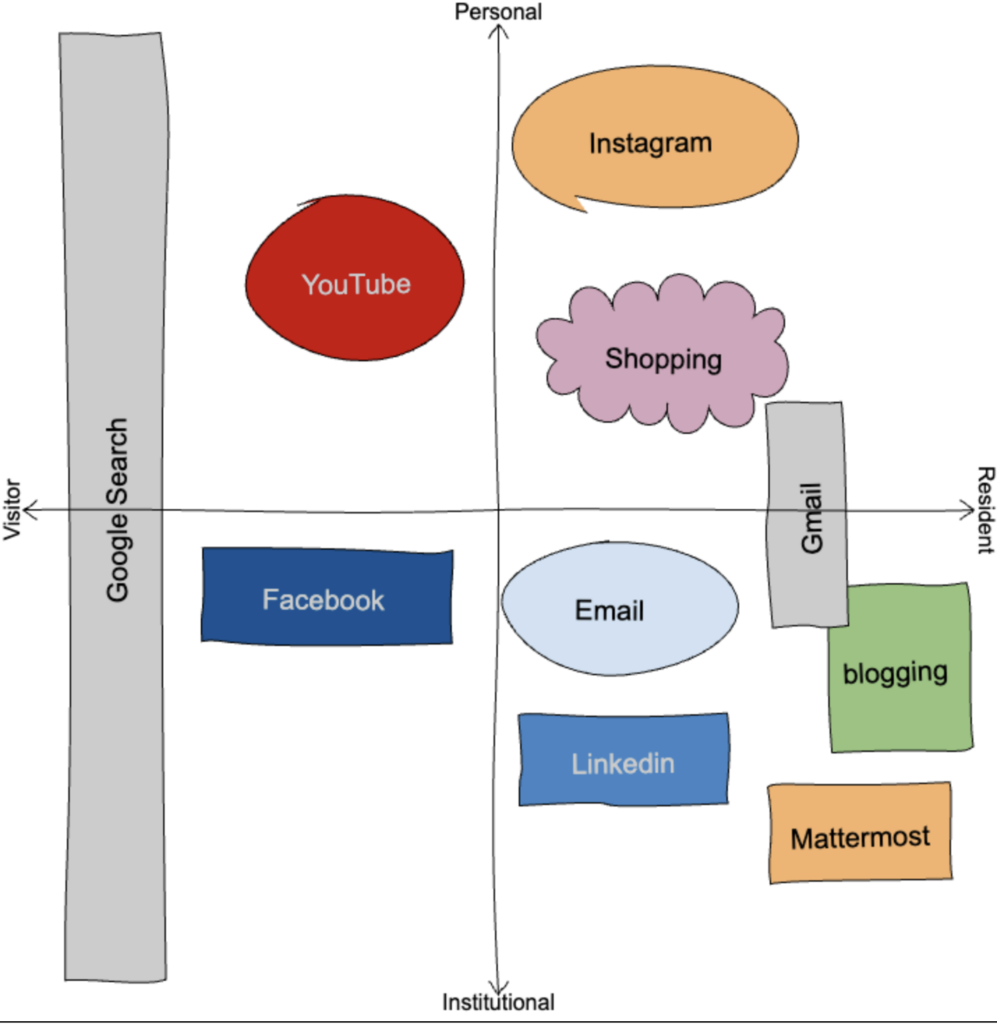
Personal digital identity is a specific digital identity associated with an individual person. It refers to the online presence that a person identifies in the digital world. Personal digital identity typically includes Social media profiles such as LinkedIn, which provides a digital identity and helps individuals to connect with others online.
Professional digital identity, on the other hand, represents an individual’s online presence that is specifically tied to their profession.
Usually, there will be an overlap between personal and professional digital identities, however, individuals often maintain separate online personalities between personal and professional digital identities for the purposes to manage their online image appropriately in different contexts.
Using Visitors and Residents mapping showed that I mainly use Instagram for personal use while LinkedIn for professional use. This is true because I have different online image depnding on the platform I use.
What digital platforms are students currently using to develop their professional network?
Students, nowadays, use different platforms to grow and maintain professional relationships with their peers and larger network. For example, LinkedIn is a professional networking platform that helps students to connect with classmates and professionals. Moreover, it is a great way to search for job opportunities related to the field of interest. Facebook Groups also offer groups focused on specific industries which allow students to join groups and connect with their peers who share the same interest.
What could the student consider in expanding their professional learning network?
Students can expand their professional learning networks by first defining their professional goals and interest that they want to connect with their PLN. Also, Engaging in online communities such as social media groups on their areas of interest can help the students to build a relationship and expand their networks. Moreover, using LinkedIn to connect with professionals by reaching out and asking for Informational interviews. This can help students to learn more about the industry they are interested in and potentially build a mentorship relationship. last but not least, using LinkedIn to connect with professionals
How do data privacy and security limit and/or promote a PLN?
Data privacy and security has an crucial effect on Professional Learning Networks (PLN). Some of the limitations include restrictions on access to certain resources. Data privacy will limit access to certain databases which might contain personal information such as in health care system where it is essential to have data privacy to protect patients’ personal information from being hacked. Moreover, data privacy promote trust and confidentiality. For example, having strong data privacy and security build trust between health care institutions and patients and this building trust within PLN
In your network how can you create a digital identity/ reputation?
I can create a digital identity by using the resident mode method where I share thoughtful content that aligns with my professional goals and expertise. Since I am interested in the pharmaceutical industry, I can share articles, blog posts to showcase my knowledge on the healthcare system by making sure that everything I am sharing is well researched to reach the target audience.
Also, using a consistent profile picture and bio to help people recognize and connect with my digital identity.
Moreover, being authentic and transparent and showing my personality in a professional manner
Building digital identity takes time, but it is important because it would be one of the main things employers will consider before hiring you, so it is important to maintain professionalism and respect while being authentic to your digital presence.
Reference
- Privacy, Ethics & Security in Digital Spaces Developing Awareness of Privacy Regan, P., & Jesse, J. (2019) https://digitaltattoo.ubc.ca/quizzes/privacy-and-surveillance/
- The Digital Visitor and Resident Continuum White. D. (2017). V and R Mapping. Retrieved from http://daveowhite.com/vandr/vr-mapping/
- What is a Visitor/Resident (PDF) http://experimental.worldcat.org/vandrmapping/assets/documents/VRAMappingInstructions.pdf
- Visitor & Resident Maps http://experimental.worldcat.org/vandrmapping/signIn


